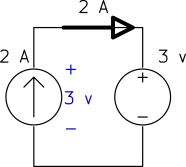This is a complicated nodal analysis problem. The circuit has two independent sources and two dependent sources. A supernode is formed to solve the problem.
Category Archives: Electrical Circuits
Reference Node and Node Voltages
A node is usually labelled as the reference node also called ground and the other node voltages are defined with respect to this point. The reference node has a potential of 0 V by definition.
Voltage Divider – Voltage Division Rule
Voltage Division Rule: The voltage is divided between two series resistors in direct proportion to their resistance. This simple rule can be used in solving simple circuits or in simplifying the solution of complicated ones. In this post, the voltage divider circuit is studied and some examples are solved to show how this rule can be deployed in solving circuits.
Problem 1-16: Voltage Divider
In this solved problem, four circuits are solved using voltage divider (the voltage division rule). Problems are arranged from simple ones to more challenging ones. It is shown how voltage divider can be used to solve simple problems.
Ideal Independent Sources
The ideal independent voltage and current sources are explained. Their symbols and voltage-current characteristics are presented. It is shown how their definitions can be used to solve problems. Some examples are also provided to clarify their characteristics.
Problem 1-15: Power of Independent Sources
Determining power of independent voltage and current sources. Passive sign and active sign conventions are used to find out which source is supplyingpower and which one is absorbing.
Problem 1-14: Current of A Voltage Source
Two simple circuits are used to demonstrate the characteristic of voltage and current sources. In both cases, the voltage sources are in series with current sources.
Problem 1-13: Voltage of A Current Source
Five circuits are considered to explain the characteristics of voltage and current sources. It is shown how voltage sources enforce their voltages on parallel elements.
Problem 1-12: Using Voltage Sources to Determine Node Voltages
A three-node circuit is solved by using the voltage of voltage sources. The nodal analysis is not used since there are enough voltage sources to determine all node voltages.
Problem 1-11: Solving a Circuit with Three Nodes by the Nodal Analysis
The circuit is solved using the Nodal Analysis. It has three nodes, two sources (one voltage, one current, both independent) and four resistors.






